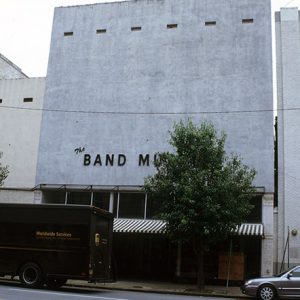calsfoundation@cals.org
Band Museum
The Band Museum in Pine Bluff (Jefferson County) housed an extensive collection of wind instruments and offered a history of the American band movement. Beginning as the personal collection of its founder, the museum grew to approximately 1,500 antique instruments and was, before its closure, the only museum in the United States devoted entirely to the history of band music and instruments.
Jerry Horne, founder of the Band Museum and a member of the American Musical Instrument Society, began collecting unusual instruments when he purchased the Wallick Music Company in 1970. His first was an old helicon (similar to a sousaphone), made by the C. G. CONN Company in 1925, which he found in the Wallick family’s garage. Soon, he began scouring flea markets, scrutinizing store trade-ins, and attending liquidation sales in a search for rare, odd, and historically significant pieces.
His collection quickly outgrew its first home, a glass display case in the Wallick store in downtown Pine Bluff. Pine Bluff’s city fathers donated a three-story building on Main Street to Horne with the stipulation that he renovate it and open a museum. The Band Museum officially opened in 1994. Some 8,500 people visited it yearly.
The focus of the museum was the array of instruments, which dated from the 1700s to the 1950s. Many were used in the circus, vaudeville, military, schools, concert halls, or dance halls. Included were numerous rarities, such as a hard-rubber clarinet (as well as several five- and seven-key Noblet clarinets), a C-melody saxophone, piccolo trumpets, and double-belled euphoniums. The euphonium was popular in the 1900s and was a regular feature in John Philip Sousa’s concerts. The double-belled euphonium has a valve to switch from one bell to the other, and while this renders a slightly lighter tone, such a feature was strictly a novelty item.
Other pieces in the collection took their fame from their players. Included was a saxophone of early jazz great Sidney Bechet, as well as a stubby little cornet once played by Merle Evans, a famed band leader in the Ringling Brothers Circus; his custom horn has shorter tubing so that he could stay in tune with the wobbly toned steam calliopes. There were two saxophones, a soprano and an alto, that Adolphe Sax himself made.
Many items in the collection were novelties that were designed to entertain concert audiences, including a self-player clarinet, a self-player sax, and a “walking stick” flute made in London circa 1850.
The Band Museum offered the occasional concert, sponsoring performances by the Russian Red Star Review, the Happy-Times Jazz Band, the Pine Bluff Community Concert Band, and the Sonny Land Big Band. By early 2010, however, the museum had closed.
“One-man Band.” Southern Living, February 1997, p. 29.
Jerry G. Horne
Band Museum
 Band Museum
Band Museum 




I visited the band museum many times with my students. On one occasion, a chaperone was looking at an old photo and exclaimed, “I’m in this photo, that’s our band!”